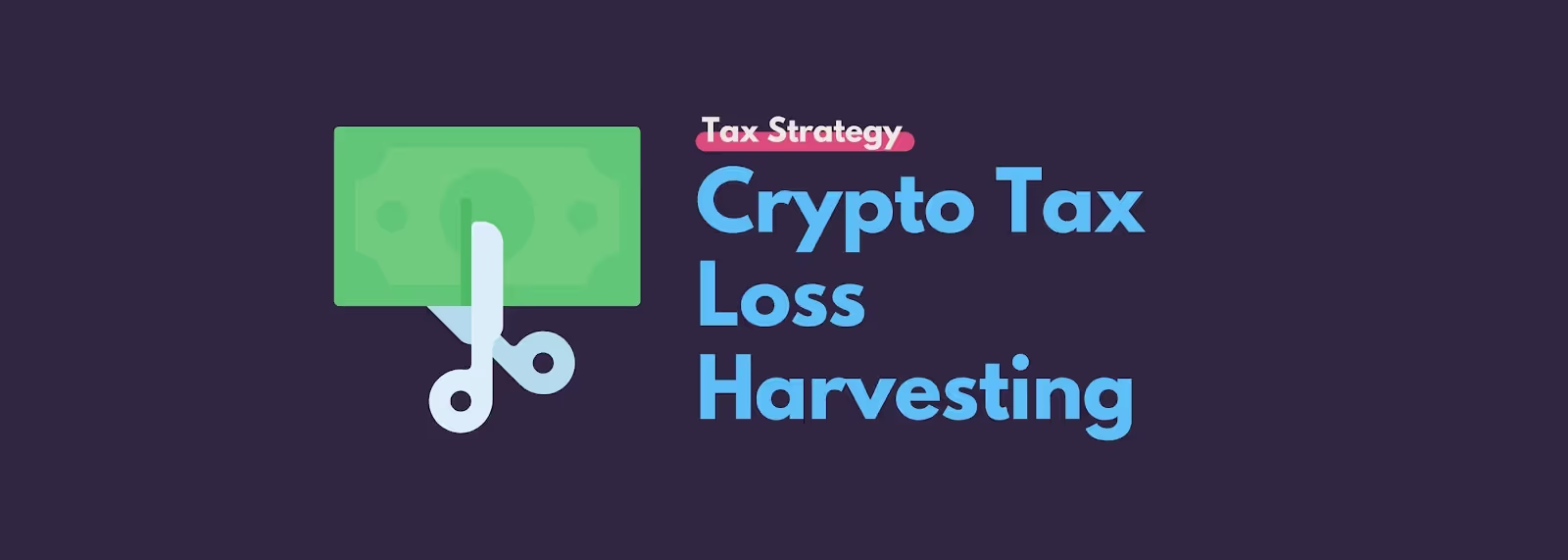.avif)
Calculate Your Crypto
Taxes in Minutes
.avif)
Investing in cryptocurrency can provide an exceptional opportunity for profit, but in the UK, it’s important to be aware of how your investment will be taxed in order to facilitate responsible financial planning. One way you can improve your tax position is through a process called Crypto Tax Loss Harvesting.
This guide will help to explain the fundamental principles, HMRC rules, and some practical strategies for UK investors to consider when it comes to tax loss harvesting.

Understanding Tax Loss Harvesting
What is Tax Loss Harvesting?
Tax loss harvesting (or tax loss selling) is a legal method of reducing taxable gains. This process involves selling an asset - such as crypto currencies, shares or property – at a loss so that a loss can offset the gains you have on other investments and reduce your total tax liability.
HMRC Allowable Losses
Before tax loss harvesting can be put into practice, it’s important to understand the HMRC allowable losses:
- Every taxpayer in the UK has a Capital Gains Tax-free allowance of£6,000 (£3,000 from April 2024-25).
- Any gain over this allowance can be offset by any losses.
- If gains are not over the allowance, loss can be carried forward to future years.
- Losses must be reported within four years once the assets have been disposed of.
- Losses cannot be claimed on any assets sold or transferred to other family members, unless a gain is made on disposal bythat family member.

Understanding Tax Loss Harvesting
Example: Crypto Investments
Let's assume you purchased Ethereum for£500 and Bitcoin for £26,000. Ethereum rises to £2,000 while Bitcoin drops to£24,000.
Without Tax Loss Harvesting you'll have:
You'll have a taxable gain of £1,500 in Ethereum.
With Tax Loss Harvesting you can:
You could sell Bitcoin at a £2,000 loss, which will offset that £1,500 gain in Ethereum.
Result:
- You will have no tax to take into account for that year and carry £500 worth of losses forward.
- HMRC And Bed And Breakfasting Transactions
- HMRC has certain restrictions in place to stop artificial losses through buying back quickly.
- Same Day Rule: If you sell and buy back the same asset in one day, you’ve used that day’s cost basis for these calculations.
- Bed and Breakfasting Rule: If you sell and buy back your position within 30 days of selling them, HMRC will use the asset’s cost basis for the month of your purchase.
- The purpose of these rules is to stop taxpayers from manipulating tax loss harvesting.

Key Dates for Tax Loss Harvesting
When tax loss harvest is appropriate depends on the timing.
In the UK the financial year runs from April 6 until April 5 the following year.
So when you're doing your tax loss harvesting you should take action prior to April 5 to stay in the same financial year.
Also, you must file your taxes by January31 of that following tax year to avoid a penalization.
Also note that the Capital Gains tax-free allowances are reducing.
2022-23: £12,300
2023-24: £6,000
2024-25: £3,000.
Sure, it is a good idea to try and maximize your gains while the allowance is still larger than £3,000.
Utilizing Kryptos for Tax Loss Harvesting
Tax loss harvesting is straightforward if you are using tax software such as Kryptos:

How to Use Kryptos
- Monitor Total Tax Liability: Be aware of how much you have gained/lost each year.
- Connect Wallets and Exchanges: Pull together all the crypto activity into one location.
- Create Tax Reports: Generate reports for self-assessment or to provide to accountants.
- Upgrade to the Paid Plan: Get the advance report options and recommendations for professional-grade analysis.
Kryptos allows you to track realized gains and unrealized gains, making it easier to comply with HMRC laws.
FAQs
1.What is tax loss harvesting, and how is it beneficial to UK crypto investors?
Tax loss harvesting is when an investor sells an asset at a loss to offset taxable gains that an investor has made. For UK investors, tax loss harvesting reduces overall tax liability and optimizes financial outcomes.
2.How do HMRC allowable losses impact tax loss harvesting?
Each taxpayer has a £6,000 Capital Gains Tax allowance. Any realized losses can offset any gains greater than £6,000;losses not used can be carried forward to the following year and beyond.
3.Can you give an example of this with crypto?
If the investor sold Bitcoin at a loss and had taken gain in Ethereum you've now reduced your taxable gains and presumably have reduced your tax liability.
4.What are the main tax loss harvesting rules HMRC has?
Same-Day Rule: The cost basis on that day.
Bed and Breakfasting Rule: The cost basis for 30 days.
These rules were created to stop artificial losses.
5.How can Kryptos assist me?
Kryptos tracks all gains/losses, connects to wallets and exchanges, and generates reports for HMRC or accountant, making tax loss harvesting easier.
| Step | Form | Purpose | Action |
|---|---|---|---|
| 1 | 1099-DA | Reports digital asset sales or exchanges | Use to fill out Form 8949. |
| 2 | Form 1099-MISC | Reports miscellaneous crypto income | Use to fill out Schedule 1 or C. |
| 3 | Form 8949 | Details individual transactions | List each transaction here. |
| 4 | Schedule D | Summarizes capital gains/losses | Transfer totals from Form 8949. |
| 5 | Schedule 1 | Reports miscellaneous income | Include miscellaneous income (if not self-employment). |
| 6 | Schedule C | Reports self-employment income | Include self-employment income and expenses. |
| 7 | Form W-2 | Reports wages (if paid in Bitcoin) | Include wages in total income. |
| 8 | Form 1040 | Primary tax return | Summarize all income, deductions, and tax owed. |
| Date | Event/Requirement |
|---|---|
| January 1, 2025 | Brokers begin tracking and reporting digital asset transactions. |
| February 2026 | Brokers issue Form 1099-DA for the 2025 tax year to taxpayers. |
| April 15, 2026 | Deadline for taxpayers to file their 2025 tax returns with IRS data. |
| Timeline Event | Description |
|---|---|
| Before January 1, 2025 | Taxpayers must identify wallets and accounts containing digital assets and document unused basis. |
| January 1, 2025 | Snapshot date for confirming remaining digital assets in wallets and accounts. |
| March 2025 | Brokers begin issuing Form 1099-DA, reflecting a wallet-specific basis. |
| Before Filing 2025 Tax Returns | Taxpayers must finalize their Safe Harbor Allocation to ensure compliance and avoid penalties. |
| Feature | Use Case Scenario | Technical Details |
|---|---|---|
| Automated Monitoring of Transactions | Alice uses staking on Ethereum 2.0 and yield farming on Uniswap. Kryptos automates tracking of her staking rewards and LP tokens across platforms. | Integrates with Ethereum and Uniswap APIs for real-time tracking and monitoring of transactions. |
| Comprehensive Data Collection | Bob switches between liquidity pools and staking protocols. Kryptos aggregates all transactions, including historical data. | Pulls and consolidates data from multiple sources and supports historical data imports. |
| Advanced Tax Categorization | Carol earns from staking Polkadot and yield farming on Aave. Kryptos categorizes her rewards as ordinary income and investment income. | Uses jurisdiction-specific rules to categorize rewards and guarantee compliance with local tax regulations. |
| Dynamic FMV Calculation | Dave redeems LP tokens for Ethereum and stablecoins. Kryptos calculates the fair market value (FMV) at redemption and during sales. | Updates FMV based on market data and accurately calculates capital gains for transactions. |
| Handling Complex DeFi Transactions | Eve engages in multi-step DeFi transactions. Kryptos tracks value changes and tax implications throughout these processes. | Manages multi-step transactions, including swaps and staking, for comprehensive tax reporting. |
| Real-Time Alerts and Updates | Frank receives alerts on contemporary tax regulations affecting DeFi. Kryptos keeps him updated on relevant changes in tax laws. | Observe regulatory updates and provide real-time alerts about changes in tax regulations. |
| Seamless Tax Reporting Integration | Grace files taxes using TurboTax. Kryptos integrates with TurboTax to import staking and yield farming data easily. | Direct integration with tax software like TurboTax for smooth data import and multi-jurisdictional reporting. |
| Investor Type | Impact of Crypto Tax Updates 2025 |
|---|---|
| Retail Investors | Standardized crypto reporting regulations make tax filing easier, but increased IRS visibility raises the risk of audits. |
| Traders & HFT Users | To ensure crypto tax compliance, the IRS is increasing its scrutiny and requiring precise cost-basis calculations across several exchanges. |
| Defi & Staking Participants | The regulations for reporting crypto transactions for staking rewards, lending, and governance tokens are unclear, and there is a lack of standardization for decentralized platforms. |
| NFT Creators & Buyers | Confusion over crypto capital gains tax in 2025, including the taxation of NFT flips, royalties, and transactions across several blockchains. |
| Crypto Payments & Businesses | Merchants who take Bitcoin, USDC, and other digital assets must track crypto capital gains for each transaction, which increases crypto tax compliance requirements. |
| Event | Consequences | Penalties |
|---|---|---|
| Reporting Failure | The tax authorities can mark uncontrolled revenues and further investigate. | Penalty fines, interest on unpaid taxes and potential fraud fees if they are deliberately occurring. |
| Misreporting CGT | Misreporting CGT Error reporting profits or losses can trigger the IRS audit. | 20% fine on under -ported zodiac signs, as well as tax and interest. |
| Using decentralized exchanges (DEXs) or mixers without records | The IRS can track anonymous transactions and demand documentation. | Possible tax evasion fee and significant fine. |
| Disregarding Bitcoin mining tax liabilities | Mining reward is considered taxable income, and failure of the report can be regarded as tax fraud. | Further tax obligations, punishment and potential legal steps. |
| Foreign crypto holdings: Non-disclosure | Foreign-accepted crypto FATCA may be subject to reporting rules. | Heavy fines (up to $ 10,000 per fracture) or prosecution for intentional non-transport. |
File Your Crypto Tax in Minutes







.avif)
